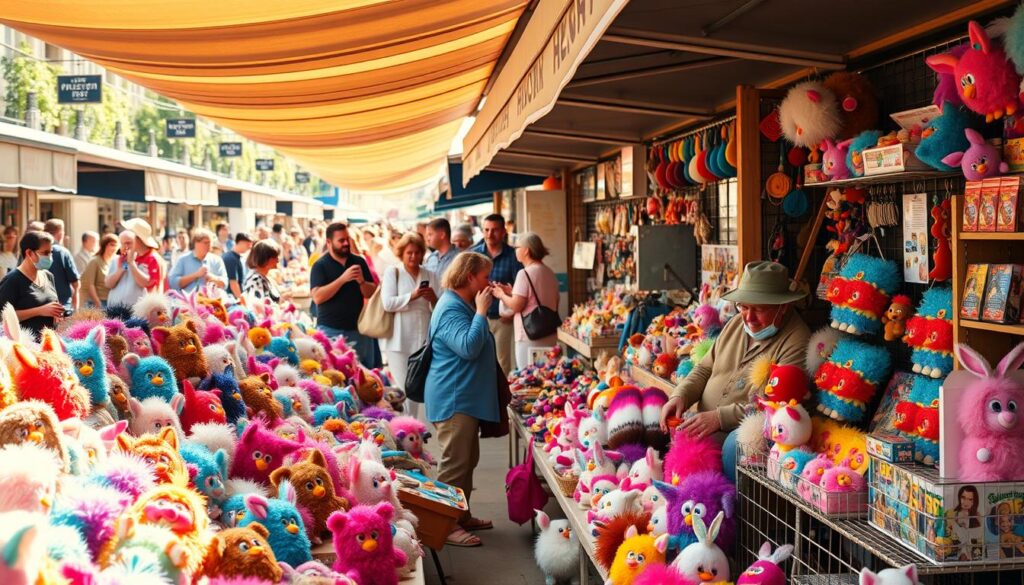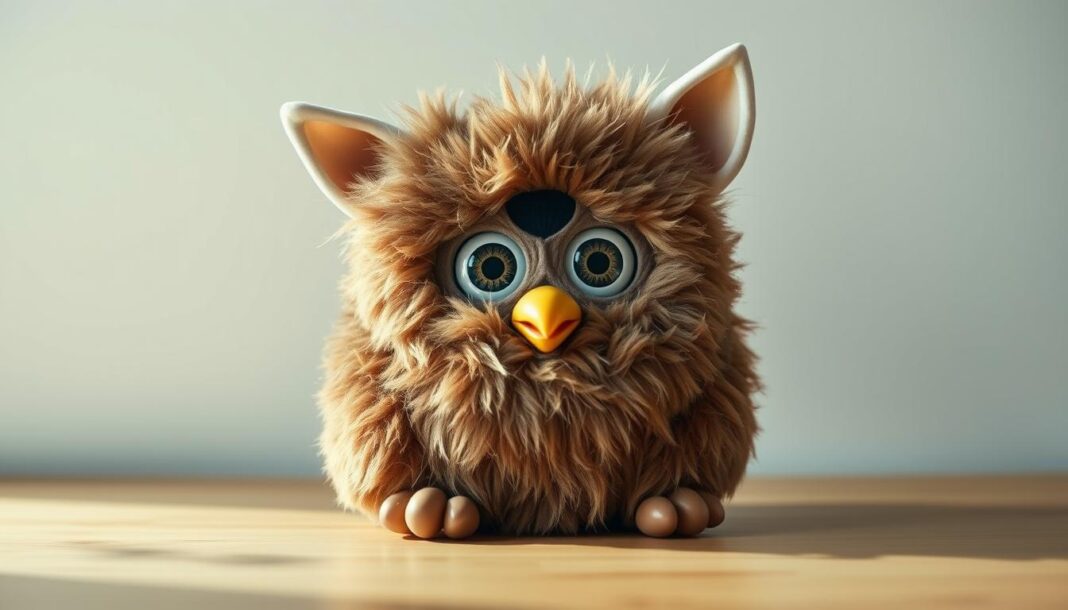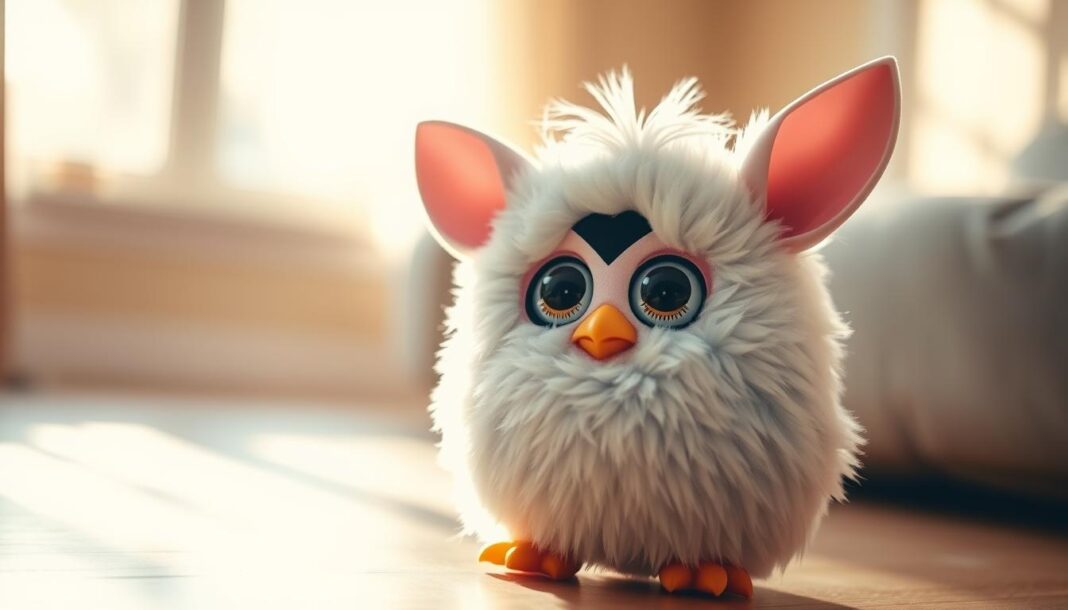Remember the iconic Furby? This lovable, interactive toy has made a huge comeback in recent years. Since its debut in 1998, over 40 million units have been sold, making it a staple of nostalgic collecting. Whether you’re rediscovering an old favorite or diving into the world of vintage toys, understanding its furby worth can be both exciting and surprising.
For instance, a 1998 original Furby in the Tiger design recently sold for $365. Even more astonishing, the rare Millennium Edition fetched a whopping $4,500 at auction. These examples show how much these toys can vary in furby value based on rarity, condition, and demand.
In this guide, we’ll help you navigate the factors that determine your Furby’s worth. From understanding different generations to spotting market trends, we’ve got you covered. Whether you’re a seasoned collector or just starting, our expertise in nostalgic toys and modern collectibles will make your journey easier. Ready to uncover the potential of your Furby? Let’s dive in!
For more insights, check out our guide on buying authentic Furbys online.
Understanding Furby Value: A Comprehensive Guide
Ever wondered why some toys become highly sought-after treasures? Furbys, with their unique charm and interactive features, have captured the hearts of collectors worldwide. Whether you’re a seasoned enthusiast or just starting, understanding what drives their appeal can be both fascinating and rewarding.
What Makes a Furby Valuable?
Several factors contribute to a Furby’s worth. Rarity is a major driver—only 500 blue/green eye models exist, making them highly desirable. Functionality also plays a role; toys with working infrared sensors can see a 15-20% increase in value.
Cultural significance adds another layer. For example, the Special Furby Angel sold for $800 on eBay, showcasing how unique designs can command high prices. A 1998 model in mint, unopened condition can fetch up to $900, proving that preservation matters.
The Role of Nostalgia in Furby Collecting
Nostalgia is a powerful force in the collectibles market. Many buyers are drawn to Furbys as a way to relive their childhood. This emotional connection often drives prices up by 20-30% compared to other vintage toys.
Take the Peanut Royal Blue Elephant Beanie Baby, which sold for $5,000. Similarly, a complete 1998 Furby set with the original Furbish manual recently sold for $1,200. These examples highlight how nostalgia and rarity combine to create lasting appeal.
Key Factors That Influence Furby Worth
Determining the worth of a collectible toy involves several key factors. From its condition to its packaging and rarity, each element plays a significant role in its appeal and market price. Let’s explore these aspects in detail to help you understand what makes your item stand out.
Condition: The Most Important Factor
The condition of your toy is the most critical factor in determining its worth. Collectors often use a grading system, ranging from “played with” (which can reduce its value by 50%) to “factory sealed.” A mint-in-box item can sell for 3-5 times the price of a loose one. Proper storage and care are essential to maintain its appeal.
Original Packaging and Its Impact
Having the original packaging can significantly boost your toy’s worth. For example, a 1998 model with its box can add $200 or more compared to a loose item. Authentication is crucial to ensure the packaging hasn’t been resealed. Experts recommend storing it in a cool, dry place to preserve its quality.
Rarity and Limited Editions
Rarity and limited edition releases drive high demand among collectors. Items like the Millennium Edition can fetch over $4,500, while the Hi-C and Furby Baby versions range from $150 to $300. Even non-official custom creations, like the 2019 Long Furby, have sold for $340. These unique pieces often become hidden gems in the market.
For more insights on rare finds, check out our guide on 1998 Furby valuations.
Furby Generations and Their Market Value
The evolution of Furbys over the years has created a diverse market for collectors. Each generation brings unique features, designs, and levels of rarity, making some more sought-after than others. Whether you’re drawn to the classics or the newer models, understanding their differences can help you identify hidden gems.
First Generation Furbys: The Classics
The 1998 original Furby remains a favorite among collectors. These models, often priced between $100 and $300, are prized for their nostalgic appeal. Discontinued colors, like the Purple Tip edition, can increase their worth by up to 35%. However, be cautious of “Frankenfurbys”—toys with mismatched parts—as they can devalue by 60%.
Later Generations: Increasing Rarity
As newer generations emerged, their rarity and unique features drove up their market appeal. For example, the Gen 2 “Giraffe” model averages $220, compared to $150 for base models. Later releases, like the 2005 Emoto-Tronic, fetch $200-$300, while Gen 7 models command a 50% premium. Collectors also seek out discontinued colors and limited editions, which often see significant value boosts.
From 1998 to 2016 Bluetooth models, each release has its own story. Gen 4 models see a 17-20% increase in worth, while Gen 6 jumps by 38-42%. These trends highlight the importance of understanding the timeline and features of each release.
Special Edition Furbys: Hidden Gems
Among the world of collectibles, limited releases stand out as hidden treasures. Special editions often captivate enthusiasts with their unique designs and stories. These versions are not just toys; they are pieces of history that collectors eagerly seek.
Promotional and Limited Edition Furbys
Promotional tie-ins have created some of the most sought-after collectibles. For example, the McDonald’s Happy Meal version ranges from $85 to $120. Target’s exclusive Cheetah design can fetch up to $275. These releases often feature unique colors or packaging, making them highly desirable.
Custom modifications also add to their appeal. Glow-in-the-dark mods can increase a toy’s worth by 20%. Authentication markers, such as original tags or unique serial numbers, are crucial for verifying rare editions.
Most Sought-After Special Editions
Some editions have become legendary in the collecting world. The Millennium Edition, for instance, has sold for over $4,500. The Rainbow Furby, with its vibrant colors, is another favorite among collectors. Here are the top five valuable editions ranked:
- Millennium Edition: $4,500+
- Special Furby Angel: $800
- Target-exclusive Cheetah: $275
- McDonald’s Happy Meal Furby: $85-$120
- Rainbow Furby: $365
For more insights on rare finds, check out our guide on original Furby valuations.
How to Assess Your Furby’s Value
Assessing the worth of your collectible can be both exciting and insightful. Whether you’re a seasoned collector or just starting, understanding how to evaluate your item is essential. Let’s explore the steps to determine its true worth.
Conducting a Physical Inspection
Start by examining your toy closely. Check the joints, sensors, and voice box for functionality. A UV light can help detect replacements or repairs that might affect its worth. Look for red flags like non-matching serial numbers, which can reduce its value by up to 40%.
Here’s a quick checklist for your inspection:
- Test all interactive features, like voice and movement.
- Inspect the exterior for scratches, discoloration, or damage.
- Verify the authenticity of parts, especially eyes and sensors.
Using Online Resources for Appraisal
Online tools and databases can provide valuable insights. Websites like FurbyCollectorsForum.com and Hasbro archives are excellent starting points. These platforms offer detailed information on rarity, market trends, and historical sales data.
For example, a recent live case study on appraising a Church Mouse model highlighted the importance of detailed research. With 58 bids on a snake-like custom item, it’s clear that unique designs can attract significant attention. Repair guides, like those for “Furby eyes,” also see over 12k monthly views, showing the demand for restoration tips.
For more detailed guidance, check out our ultimate shopping companion to help you navigate the market with confidence.
Record-Breaking Furby Sales
Collectors worldwide have been amazed by the staggering prices some Furbys command. From auctions to private sales, these iconic toys have broken records, proving their lasting appeal. Whether it’s rare editions or pristine condition, certain items stand out in the collectibles market.
The Most Expensive Furbys Ever Sold
Some sales have left even seasoned collectors in awe. The Special Furby Angel, for instance, fetched $800 on eBay. Another standout is the Kids Cuisine Furby, which sold for $520 in Canada. Even the original box alone can command $360, showcasing the importance of packaging.
Heritage Auctions, a leading toy department, reports that provenance documentation plays a key role in these high-profile sales. For example, the Millennium Edition’s $4,500 sale was backed by detailed records, making it a prime example of an investment-grade collectible.
What Makes These Furbys So Valuable?
Several factors drive these record-breaking prices. Rarity is a major factor—limited editions like the Rainbow Furby are in high demand. Condition is equally critical; items in mint or factory-sealed condition often fetch the highest prices.
Comparing these sales to other collectibles, like the 1969 Volkswagen Beach Bomb ($150k), highlights the potential of toys as investments. Experts predict that prototypes, such as the 2012 Furby Boom, could become future “blue chips” in the market.
For more insights into the psychology behind these collectibles, check out our guide on the fear factor in Furby collecting.
Tips for Maintaining Your Furby’s Worth
Keeping your collectible in top shape ensures its long-term appeal. Whether you’re a seasoned collector or just starting, proper care can make a significant difference. Let’s explore practical steps to preserve your item’s condition and enhance its worth.
Proper Storage and Care
Storing your toy correctly is crucial for its preservation. Sunlight exposure can fade colors in just six months, while battery corrosion ruins 23% of stored items. To avoid these issues, follow these guidelines:
- Keep your collectible in a climate-controlled environment (65-70°F, 45-50% humidity).
- Remove batteries to prevent corrosion and damage.
- Use a soft-bristle brush for gentle cleaning to avoid scratches.
For added protection, consider investing in a display case. Here’s a comparison of popular options:
| Display Case Type | Features | Best For |
|---|---|---|
| UV-Filtering | Blocks harmful rays, prevents fading | Long-term storage |
| Regular | Basic protection, affordable | Short-term display |
Handling and Cleaning Tips
Handling your toy with care is just as important as proper storage. Always wash your hands before touching it to avoid transferring oils or dirt. Use a cleaning kit with a soft-bristle brush to gently remove dust and debris.
If your item has original packaging, store it in a cool, dry place to maintain its quality. For added security, consider a collectibles rider policy to protect your investment. These simple steps can help you preserve your cherished toy for years to come.
For more detailed insights, check out our Furby value chart to stay updated on market trends.
Where to Buy and Sell Furbys
Finding the right place to buy or sell collectibles can make all the difference. Whether you’re hunting for a rare edition or looking to part with a cherished item, knowing your options is essential. Let’s explore the best platforms and strategies to help you navigate the collectibles market with confidence.

Online Marketplaces for Furbys
The online world offers a variety of platforms for collectors. eBay, for example, sees over 300 monthly transactions, making it a popular choice. Etsy, with its focus on handmade and vintage items, is another great option. Here’s a quick comparison:
- eBay: Lower fees but higher competition.
- Etsy: Craft-focused, ideal for unique or custom items.
When selling, consider bundling items to attract buyers. Always be cautious of scams, like fake shipping labels, which have become a recent trend.
Brick-and-Mortar Stores for Collectors
For those who prefer in-person shopping, physical stores are a treasure trove. Iconic shops like NYC’s Toy Tokyo and LA’s Wacko are known for their impressive collections. Nearly 78% of vintage toy shops stock these items, so you’re likely to find something special.
Meetup groups, like FurbyCon, are also gaining popularity, with attendance up 18% year-over-year. These events offer a chance to connect with fellow enthusiasts and discover hidden gems.
The Future of Furby Collecting
The world of toy collecting is evolving rapidly, and these interactive treasures are at the forefront. With the toy collectibles market projected to reach $35.3 billion by 2032, the future looks bright for enthusiasts. Gen Z is driving this growth, with hashtags like #FurbyTok amassing over 850 million views on social media.
Emerging markets, particularly in Southeast Asia, are seeing a 25% increase in demand. This global interest is reshaping how collectors engage with their favorite items. Technology is also playing a role, with trials of NFT verification adding a new layer of authenticity to the hobby.
Sustainability is another key trend. Battery-free modifications are gaining popularity, appealing to eco-conscious collectors. Beyond the dollars, the emotional connection to these toys remains their true value. For more insights, explore our guide on original Furby valuations.


